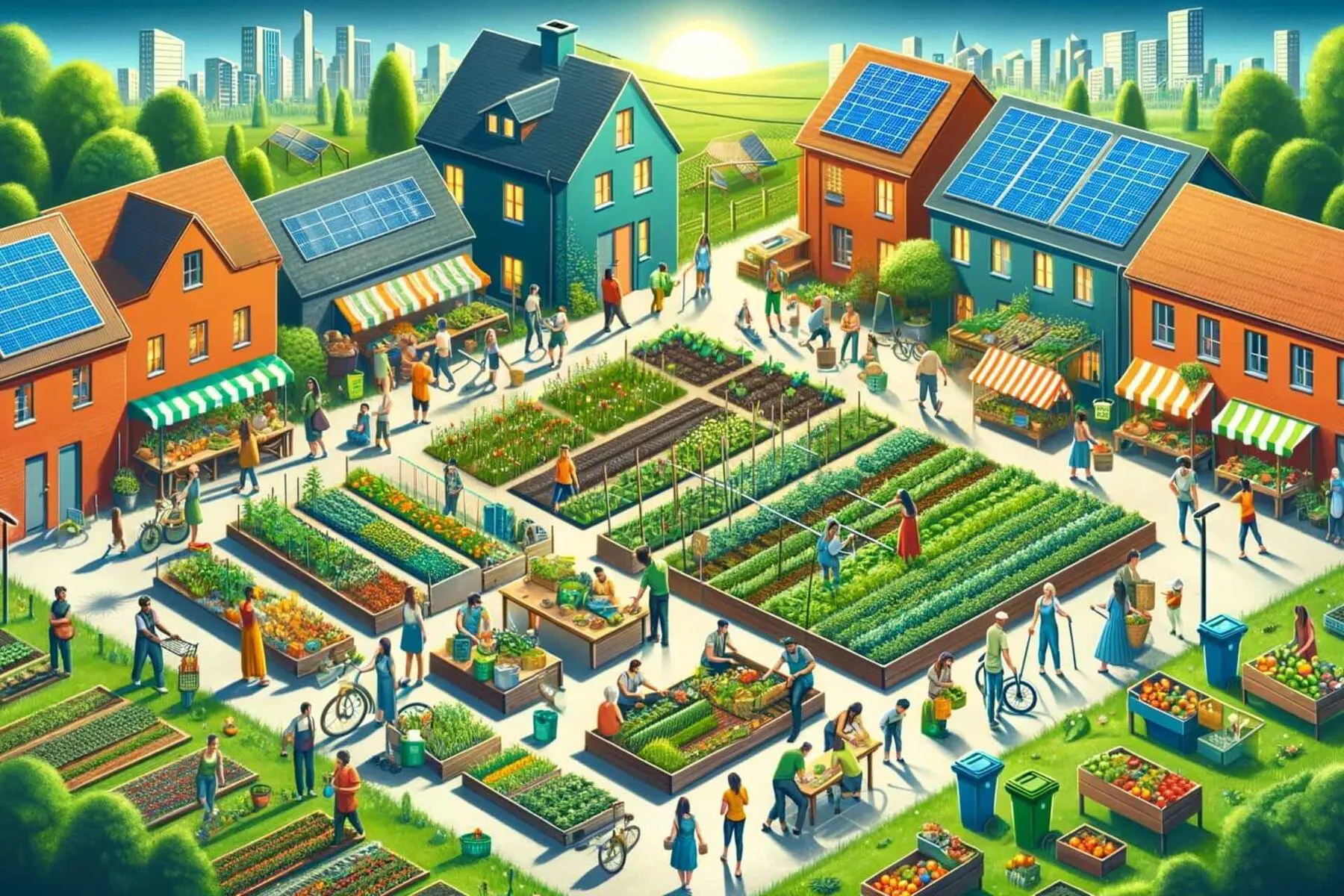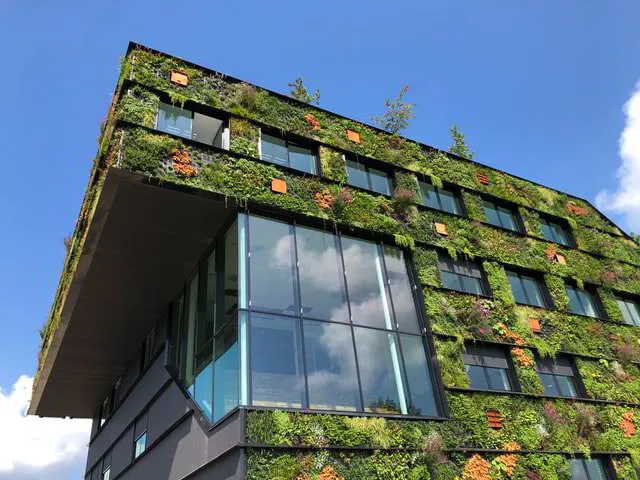Embracing a green lifestyle means adopting habits that benefit the natural environment, and enhance personal finances.
This approach, increasingly popular as noted by leading sustainability advocates, involves making eco-friendly choices in daily life—from conserving energy to reducing waste.
Such practices not only help in preserving our planet but also lead to significant financial savings. As awareness grows, more individuals turn towards sustainable living, recognizing its dual impact on environmental health and personal economic well-being.
This shift reflects a growing global consciousness towards a more sustainable and financially prudent way of life.
1. Understanding Sustainable Living
Sustainable living, as defined by leading environmental experts, is a lifestyle that seeks to reduce an individual's or society's use of the Earth's natural resources and personal resources.
It emphasizes living within our means, focusing on reducing carbon footprints through altering transportation methods, energy consumption, and diet.
The importance of this lifestyle in today's world cannot be overstated—it's a response to escalating environmental issues like climate change, deforestation, and loss of biodiversity.
From a modern perspective, sustainability is increasingly intertwined with technological advancements.
Innovations in renewable energy, such as solar and wind power, are making sustainable living more accessible and efficient. Smart home technologies and energy-efficient appliances are becoming commonplace, aiding in reducing energy consumption.
Furthermore, the rise of digital platforms promotes the sharing economy, reducing waste and encouraging more sustainable consumption patterns.
This contemporary approach to sustainability addresses environmental concerns and adapts to the evolving technological landscape, making sustainable living more practical and achievable in everyday life.
Easy and Practical Tips for Sustainable Living:
- Reduce Plastic Use: Start by replacing single-use plastics with reusable alternatives like metal straws, cloth bags, and glass containers.
- Energy Efficiency: Switch to LED bulbs and unplug electronics when not in use.
- Conscious Consumption: Buy less and choose items with less packaging or made from recycled materials.
- Recycle and Compost: Sort your waste and start a compost bin for organic waste.
- Water Conservation: Fix leaks and install low-flow fixtures.
First Month Guide to Transitioning to a Green Lifestyle:
- Week 1: Audit your daily habits to identify areas for improvement. Start using reusable bags and bottles.
- Week 2: Implement a recycling system in your home. Begin composting kitchen scraps.
- Week 3: Focus on reducing energy consumption. Switch to LED bulbs and adopt energy-saving practices.
- Week 4: Evaluate your shopping habits. Start buying bulk where possible and choose eco-friendly products.
- End of Month: Reflect on the changes made. Plan to tackle another area of sustainable living, like sustainable transportation or diet, in the following month.
As you conclude your first month of sustainable living, remember that each small change contributes to a larger environmental impact. Embrace this journey with patience and curiosity, and watch your green lifestyle evolve and flourish.
3. Sustainable Fashion and Beauty
Sustainable fashion and beauty choices are increasingly important today, where environmental concerns and ethical considerations are at the forefront of consumer consciousness.
These choices involve selecting products and brands that prioritize using eco-friendly materials, ethical labor practices, and minimal environmental impact.
Importance of Sustainable Fashion and Beauty:
Sustainable fashion and beauty are about more than just the products we use; they represent a commitment to protecting the environment and supporting ethical labor practices.
Consumers can help reduce pollution, conserve natural resources, and promote fair working conditions by choosing sustainable options.
Eco-Friendly Products and Brands:
Many sustainable fashion brands focus on using recycled or organic materials, reducing waste in their production processes, and ensuring fair labor practices.
In beauty, the emphasis is on products free from harmful chemicals, packaged in recyclable or biodegradable materials, and not tested on animals.
Popular sustainable fashion brands include Patagonia and Stella McCartney, known for their eco-conscious approach. In beauty, brands like Lush and The Body Shop are celebrated for their commitment to sustainability.
New Sustainable Brands and DIY Beauty Recipes:
1. Emerging Sustainable Brands:
- Fashion: 'Everlane' and 'Girlfriend Collective' are making waves with transparent pricing and commitment to ethical manufacturing.
- Beauty: 'Ethique' and 'Elate Beauty' stand out for their zero-waste packaging and natural ingredients.
2. DIY Beauty Recipes:
- Avocado Hair Mask: Mash a ripe avocado with a tablespoon of olive oil and apply it to your hair for a nourishing, natural treatment.
- Coffee Body Scrub: Mix ground coffee with coconut oil and sugar for an exfoliating and invigorating body scrub.
- Turmeric Face Mask: Combine turmeric powder, yogurt, and honey for a face mask that brightens and evens out skin tone.
By incorporating these sustainable practices and exploring new brands and homemade beauty solutions, individuals can significantly impact the environment and their own health.
The shift towards sustainable fashion and beauty is not just a trend but a necessary move towards a more responsible and conscious lifestyle.
Eco-Friendly Home Decor:
- Choose Sustainable Materials: Opt for furniture and decor items made from recycled, reclaimed, or sustainably sourced materials. This reduces the demand for new resources and supports recycling efforts.
- Energy Efficiency: Switch to LED lighting, which consumes less energy and lasts longer than traditional light bulbs. Consider energy-efficient appliances like ENERGY STAR-labeled appliances as well.
- Natural Elements: Incorporate indoor plants into your decor. They purify the air and add a calming, natural element to your home.
Sustainable Gardening:
- Native Plants: Use plants native to your region as they require less water and maintenance and support local wildlife.
- Organic Practices: Avoid chemical fertilizers and pesticides. Opt for organic alternatives or make your own natural pest repellents.
- Water Conservation: Implement rainwater harvesting or drip irrigation systems to conserve water.
Starting a Vegetable Garden:
- Begin Small: If you're new to gardening, start with a small plot or container garden. Choose vegetables that are known to be easier to grow, like tomatoes, bell peppers, lettuce, or herbs.
- Soil Quality: Use high-quality organic soil rich in nutrients. Good soil is the foundation of a healthy garden.
- Sunlight and Watering: Ensure your garden gets enough sunlight (most vegetables need about 6-8 hours of sun daily) and water your plants regularly, preferably in the morning or evening.
Composting:
- Set Up a Compost Bin: You can buy a compost bin or make one yourself. Place it in a convenient spot in your yard.
- Collect Scraps: Save kitchen waste food scraps like fruit and vegetable peels, coffee grounds, and eggshells. Avoid meat and dairy products as they can attract pests.
- Balance Your Compost: Combine green waste (kitchen scraps) with brown waste (dry leaves, branches, paper). This balance is crucial for effective composting.
- Maintenance: Turn your compost pile every few weeks to aerate it, which speeds up the composting process.
By following these tips and comparing them with the suggestions of competitors, you can see that many principles of eco-friendly living are universal.
Yet, there's always room for personalization and adaptation to your specific environment and lifestyle. Starting with these small steps can significantly positively impact the environment and your quality of life.
5. Reducing Waste in Everyday Life
Reducing waste in everyday life is a key component of sustainable living, particularly in areas like personal care, household and natural cleaning products, and fashion.
By adopting certain strategies and incorporating some unique hacks, it's possible to cut down on waste significantly.
Personal Care:
- Refillable Products: Choose refillable options for products like shampoo, soap, and deodorant. Many brands now offer refill stations or returnable containers.
- DIY Skincare: Make your own skincare products using natural ingredients like coconut oil, sugar scrubs, or apple cider vinegar. This reduces packaging waste and lets you control what goes on your skin.
- Sustainable Menstrual Products: Consider using menstrual cups or reusable cloth pads, which are less wasteful than disposable products.
Household Cleaning:
- DIY Cleaning Solutions: Create your own cleaning products using ingredients like vinegar, baking soda, and lemon. This reduces the need for multiple plastic bottles of commercial cleaners.
- Microfiber Cloths: Use microfiber cloths instead of disposable paper towels for cleaning. They are more effective and can be washed and reused many times.
- Bulk Buying: Purchase cleaning supplies in bulk to reduce packaging waste.
Fashion:
- Capsule Wardrobe: Embrace a capsule wardrobe, which focuses on a smaller number of versatile, high-quality pieces. This approach reduces the constant need for new clothes.
- Second-Hand Shopping: Buy clothes from thrift stores or swap clothes with friends. This extends the life of garments and reduces demand for new production.
- Clothing Care: Take good care of your clothes. Simple practices like washing in cold water, air drying, and repairing minor damages can extend the life of your garments.
Unique Waste Reduction Hacks:
- Soap Nuts for Laundry: Use soap nuts as a natural, reusable alternative to laundry detergent.
- Reusable Beeswax Wraps: Replace plastic bags and cling film with beeswax wraps for food storage. They are washable and reusable.
- Digital Receipts: Opt for digital receipts to reduce paper and plastic waste too.
Incorporating these strategies, along with those commonly suggested by competitors, such as recycling and reducing single-use plastics, can significantly reduce household waste. Each small change has a larger impact on environmental conservation and sustainable living.
6. Sustainable Eating and Cooking
Sustainable eating and cooking are integral to reducing one's environmental footprint, with a plant-based diet and eco-friendly cooking practices leading the charge to reduce your carbon footprint.
This approach benefits the planet and the food chain and can be healthier and surprisingly budget-friendly.
Importance of a Plant-Based Diet:
A plant-based diet, which emphasizes fruits, vegetables, grains, nuts, and seeds, has a significantly lower environmental impact compared to diets high in meat and dairy. This is due to lower greenhouse gas emissions, reduced water usage, and less land required for cultivation.
Competitors in the sustainable lifestyle space often highlight these benefits, advocating for reducing meat consumption as a key strategy for environmental conservation.
Sustainable Cooking Practices:
- Energy Efficiency: Use energy-efficient cooking methods like pressure cooking or steaming, which reduce energy consumption.
- Batch Cooking: Prepare meals in large batches to save energy and reduce food waste.
- Mindful Shopping: Buy local and seasonal produce to reduce the carbon footprint associated with transportation and storage.
Budget-Friendly, Sustainable Recipes:
- Lentil Soup: Lentils are a cost-effective and protein-rich ingredient. A simple lentil soup with vegetables, herbs, and spices can be nourishing and environmentally friendly.
- Stir-Fried Vegetables and Tofu: Use a variety of seasonal vegetables and tofu for a high-protein, low-cost meal. Tofu is a sustainable alternative to meat and can be flavored in numerous ways.
- Vegetable Curry with Chickpeas: Chickpeas are another affordable and sustainable protein source. A vegetable curry with chickpeas, coconut milk, and spices can be served with rice for a filling, plant-based meal.
Incorporating these guidelines and recipes into your lifestyle aligns with the advice of many competitors in the field, emphasizing the importance of plant-based diets and sustainable cooking practices.
Not only do these choices support environmental sustainability, but they also offer a pathway to a healthier lifestyle. They can be quite economical, making sustainable eating accessible to a wider audience.
Friendly Travel and Transportation Options:
- Public Transportation: Utilizing buses, trains, and subways effectively lowers carbon emissions. It's more energy-efficient than individual car usage and helps reduce traffic congestion.
- Cycling and Walking: Opting for bicycles or walking offers a zero-emission solution for shorter distances, contributing positively to both environmental health and personal fitness.
- Carpooling and Ride-Sharing: Sharing rides with others can significantly decrease the amount of emissions per person, making it a more sustainable choice than solo driving.
Sustainable Travel Practices:
- Direct Flights: Choosing direct flights can reduce fossil fuel consumption and carbon dioxide emissions.
- Eco-Friendly Accommodations: Staying in hotels or lodgings that practice sustainability, such as using renewable energy or recycling, can make a big difference.
- Responsible Tourism: Engaging in tourism that respects and preserves local ecosystems and cultures is crucial.
Latest Trends in Sustainable Transportation:
- Electric Vehicles (EVs): The increasing availability and improvement of electric vehicles mark a significant step towards sustainable personal transportation. With advancements in range and charging infrastructure, EVs are becoming a practical option for many.
- Hybrid Vehicles: As a transitional technology, hybrid vehicles offer improved fuel efficiency and lower emissions than conventional vehicles.
- Bike-Sharing Programs: Many urban areas now offer bike-sharing systems, making it convenient to choose cycling for short trips.
- Sustainable Aviation Fuels (SAFs): Innovations in aviation fossil fuels are underway, aiming to reduce the carbon footprint of air travel.
Adopting these eco-friendly travel and transportation methods significantly reduces our carbon footprint. As technology advances and more sustainable options become available, it becomes easier for individuals to make choices that align with a greener lifestyle.
8. Investing in Sustainability
Investing in sustainability is an increasingly important aspect of responsible financial management. It involves directing your money towards companies and funds that prioritize environmental and social responsibility.
This section covers the basics of ethical banking and sustainable investments, offering a beginner's guide to green investing.
Ethical Banking:
Ethical banking chooses financial institutions committed to socially responsible investment (SRI) practices.
These banks often support projects with positive environmental impacts, such as renewable energy and conservation efforts, and avoid investing in industries that are harmful to the planet, like fossil fuels or deforestation.
Sustainable Investments:
Sustainable investments focus on companies and funds that adhere to environmental, social, and governance (ESG) criteria. This approach not only considers the financial return but also the societal and environmental impact of the investment.
Beginner's Guide to Green Investing:
- Research: Start by researching banks and investment funds that align with your values. Look for those with strong ESG ratings.
- Diversification: As with any investment strategy, diversification is key. Spread your investments across different sectors and companies to mitigate risk.
- Start Small: You don’t need much money to start. Many ethical funds and green stocks are accessible with minimal initial investment.
- Stay Informed: Keep up with news and trends in sustainability to make informed decisions about where to invest your money.
- Seek Advice: Consult a financial advisor specializing in ethical and sustainable investments.
While other resources and guides might offer similar foundational advice, the emphasis is on a beginner's practical steps to start investing sustainably.
The focus is on making green investing accessible and understandable, even for those new to finance. By investing in sustainability, you can see a financial return and contribute to the broader movement towards a more sustainable and equitable world.
9. Community and Lifestyle
The role of the community in supporting a green lifestyle is pivotal. It's within communities that sustainable practices are often nurtured, shared, and amplified, leading to broader environmental impact.
Communities provide support for individuals trying to live more sustainably, offering shared resources, knowledge, and encouragement.
Community Support in Sustainable Living:
- Shared Resources: Community gardens, tool libraries, and car-sharing programs are examples of how communities can pool resources for mutual benefit, reducing individual consumption and waste.
- Knowledge and Skill Sharing: Workshops, local environmental groups, and online forums allow community members to share tips on sustainable living, from composting to energy-saving techniques.
- Collective Action: Communities can come together for beach clean-ups, tree planting, or advocating for local environmental policies, making a larger impact than individual efforts alone.
Stories of Individuals Making a Difference:
Many individuals within communities have made significant strides in promoting sustainability. For example, there's the story of a woman who started a local composting program in her neighborhood, significantly reducing food waste.
Another inspiring tale is of a teenager who organized a city-wide recycling initiative, educating residents and setting up recycling stations.
Interviews with Local Sustainability Heroes:
- Urban Gardener: An interview with someone who transformed vacant city lots into thriving community gardens can inspire others to see potential in unused spaces.
- Zero-Waste Advocate: Talking to a local resident who has successfully adopted a zero-waste lifestyle can provide practical tips and motivation for others.
- Renewable Energy Enthusiast: Insights from someone who has implemented solar panels or other renewable energy sources in their home can demystify the process and encourage adoption.
By highlighting these stories and interviews, the article can showcase real-life examples of how individual actions, supported by community efforts, can lead to significant environmental benefits.
It emphasizes that while the journey to a green lifestyle is personal, community support and collaboration can be powerful catalysts for change.
10. Overcoming Challenges
Living sustainably often comes with its set of challenges, which can vary depending on one's lifestyle, resources, and circumstances.
Recognizing and addressing these obstacles is crucial for making sustainable living more accessible and achievable for everyone, including students, families, and other demographics.
Common Obstacles in Sustainable Living:
- Cost Concerns: Often, eco-friendly products are perceived as more expensive than conventional alternatives. This can be a significant barrier for many people.
- Availability and Accessibility: In some areas, access to sustainable products or resources like recycling facilities and organic food markets can be limited.
- Lack of Information: Many individuals may want to live more sustainably but don't know where to start or lack information about sustainable practices.
- Convenience and Time Constraints: Busy lifestyles can make it challenging to adopt practices that are seen as less convenient, such as public transportation or cooking from scratch.
Tailored Solutions for Different Demographics:
1. For Students:
- Budget-Friendly Sustainable Choices: Look for second-hand or thrifted items, use digital instead of paper, and participate in or organize clothes swaps.
- Sustainable Transport: Utilize bike-sharing programs or public transportation, often discounted for students.
2. For Families:
- Eco-Friendly Family Activities: Engage in activities like gardening or DIY crafts that are both sustainable and family-friendly.
- Bulk Buying and Meal Planning: Purchase food in bulk to reduce packaging waste and plan meals to minimize food waste.
3. For Urban Residents:
- Community Involvement: Join or start community initiatives like urban gardens or composting programs.
- Maximize Small Spaces: Utilize balcony gardens or indoor plants to improve air quality and biodiversity.
4. For Rural Residents:
- Local Resources: Take advantage of local produce and materials and engage in practices like rainwater harvesting.
- Energy Efficiency: Explore options for renewable energy sources like solar panels, which can be more feasible in rural areas.
Addressing these challenges with specific solutions tailored to different lifestyles and needs makes sustainable living more inclusive and practical.
It's about finding the right balance and making small, consistent changes that collectively lead to a significant positive impact on the environment.
Summary
This article explores the multifaceted approach to living green, emphasizing the importance of sustainable choices in areas like fashion, beauty, home and garden, and diet.
It highlights the role of the community in fostering sustainability and addresses common challenges, offering tailored solutions for diverse demographics.
From adopting eco-friendly travel and transportation options to ethical banking and investments, the article provides practical tips and inspiring stories to guide you on your journey to sustainability.
Embrace these actionable green living tips, and let them be your starting point toward a more environmentally conscious and responsible way of living. Every small change contributes to a larger impact on a healthier planet.
Explore more about energy efficiency here.
Scott Harding
Scott is the main author of DIY Home Comfort. He's also an experienced HVAC technician that enjoys home renovation and spending time with his family. You can find out more about him here.












